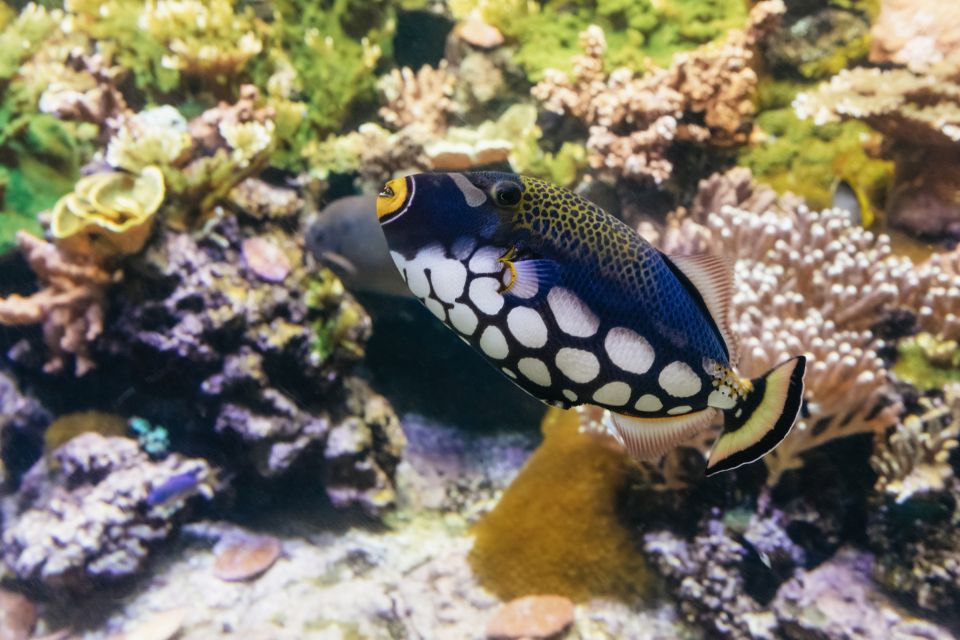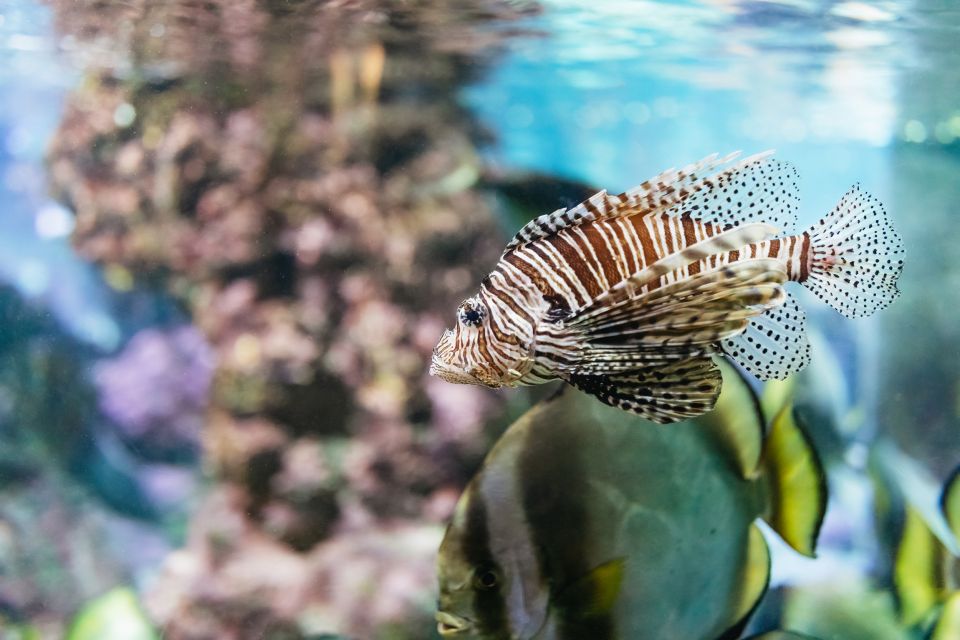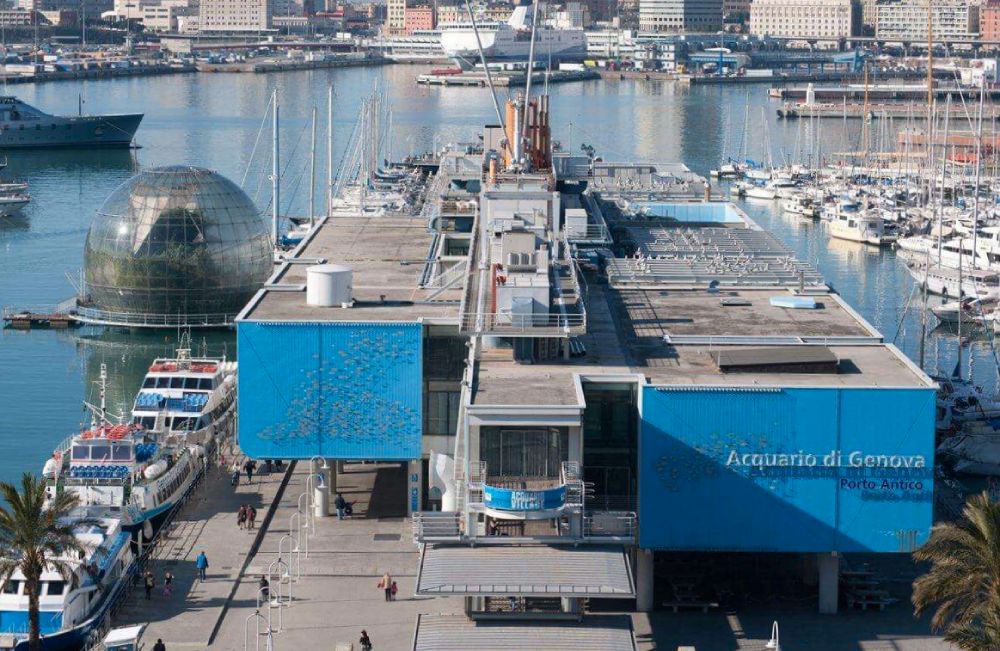The Aquarium of Genoa is the biggest in Europe in terms of the number of animals it houses. It boasts an exceptional display of aquatic biodiversity. For these reasons, the Aquarium is the primary attraction in the Porto Antico area in Genoa, drawing in visitors from different parts of the world. In this post, you’ll find out about the animals living in the Aquarium and all the necessary information to help you plan your visit.
Table of Contents
What to see at the Aquarium of Genoa
The Aquarium of Genoa is a large facility that requires at least half a day to explore thoroughly. It has an exhibition area of 27,000 square meters and houses 12,000 animals and 200 plant species divided into thematic areas.
ORGANISE YOUR TRIP TO GENOA
Save money with the Genoa City Pass, unlocking a wealth of cultural experiences and seamless travel within the city. It provides access to several museums and free public transport during its validity period.
Stay connected in Italy with an Airalo eSim, the best online solution for data and phone coverage on your trip to Genoa.
Animals can swim in spaces not visible from the main window for their well-being, so visitors may have to look closely to see their favourite species. The tanks are enormous and filled with filtered and constantly monitored seawater.
Tanks dedicated to penguins, sharks, seals, and manatees have two viewing areas, one above and one below the water. Visitors can observe them in their reconstructed land and sea habitats.

Sharks and predators of the sea
The shark bay is a tank dedicated to marine predators. It is home to several shark species, including two sawfish recognisable by their long, toothed rostrum. You can try to see them at the bottom, where they are used to swimming.
Penguins and Antarctic marine species
Marine species in the Antarctic have developed an extraordinary adaptation to survive in extreme conditions. In contrast to the continent’s interior, numerous invertebrates, fish, seals, and penguins live in the Antarctic marine waters.
Dolphins and Cetaceans
The Cetacean Pavilion is the most famous section of the Genoa Aquarium, as it houses four open-air tanks home to endangered bottlenose dolphins. Visitors can enjoy an immersive experience, observing the dolphins from the surface or below the water level to see them swim.
During my visit to the Acquario di Genova, I learned that you can recognise dolphins by the marks on their fins. Trainers do not force their jumps and games but rather a natural part of their communication and socialisation.
The Aquarium also funds several studies on dolphins conducted by ethologists and veterinarians, ranging from their relationships to how they sleep one hemisphere of their brain at a time, allowing them to come up to the surface to breathe.
Jellyfish
The jellyfish room houses nine tanks with species from different seas worldwide. In this themed area, you can discover the main stages of the life cycle of jellyfish, ancient organisms with no heart or brain. The jellyfish ‘dance’ display is fascinating because it seems as if the jellyfish are moving to the rhythm of the music in the background.
Interactive installations
There are various interactive installations available to explore during the Genoa Aquarium tour. These include the penguin pavilion, where you can touch the ice, and the enlarged coral exhibit, where you can discover different textures. You can also create a virtual fish in the Fish Making area, give it a name, and release it on a giant screen with other visitors’ creations.
Moreover, marine animals can inspire the creation of environmentally sustainable technologies. At the end of the tour, you can see a robotic octopus arm made of silicone by a research team from IIT, the Italian Institute of Technology. This arm can lift objects much heavier than its weight and functions both dry and immersed in fluids such as water and oils.
Activities at the Genoa Aquarium
In the Biodiversity Pavilion built in 1998 in the hull spaces of the Nave Italia (or Nave Blu), you can see the fauna and flora of the rainforests. The main attraction of this room is the touch tank in which you can pet the stingrays, following the instructions on the panels. Around the stingray tank, display cases contain snakes, iguanas, turtles and other amphibious animals.
Extra activities for a fee
The Acquario di Genova offers extra activities for a fee, such as guided tours with the aquarium biologists to discover the activities required to maintain the tanks and care for the animals. You can participate on weekends and public holidays by purchasing the Behind the Scenes tickets for € 8 at the dedicated desk at the Cetacean Pavilion.
Alternatively, if you book in advance, you can plan a themed visit with a biologist dedicated to your group or an encounter with the dolphins by the pool with Acquario di Genova’s trainers. Contact the Aquarium at least three days before your visit to book these extra activities.

Marine animal protection at the Genoa Aquarium
The Genoa Aquarium is actively involved in several scientific projects to protect biodiversity. Its mission is to raise public awareness about the conservation of aquatic environments. The aquarium has also contributed funds toward scientific expeditions to Antarctica, Mali, and Madagascar that resulted in the discovery of four new species of chameleons and three frogs in Madagascar.
The Aquarium participates in the Emys project, which focuses on the conservation of the marsh tortoise endemic to the Albenga plain. It also takes part in the Metropolitan Dolphins project, which studies the presence and habits of coastal dolphins and their relationships with human activities.
Furthermore, aquariums also play a significant role in caring for injured animals and their subsequent release into the sea. Over the years, the Acquario di Genova has responded to more than 150 First Aid requests for sea turtles in difficulty on the Ligurian coasts. The Aquarium took care of about 100 injured turtles and released them into the sea.
Practical information to visit the Aquarium of Genoa
The Genoa Aquarium is a must-see attraction in the Ligurian capital, whether travelling alone or with your family. When visiting with children, a trip to the Aquarium can be a truly magical experience.
To make the most of your visit to the Aquarium, I recommend avoiding bank holidays and school terms as these dates have the highest attendance. Additionally, remember that the Acquario di Genova is much quieter in the afternoon as cruise passengers typically return to their ships.
How much Aquarium of Genoa tickets cost
Tickets for the Acquario di Genova cost €27 for adults and €18 for children aged 4 and above. Children up to 3 years old can enter for free. To save money and time, buy your tickets online and avoid the queue at the ticket office.
If you plan on visiting during public holidays, school holidays or when a cruise ship docks, it is best to check ahead and book your tickets directly on the availability calendar by selecting the date of your visit.
How much time do you need to visit the Aquarium of Genoa
The visit to the Genoa Aquarium takes about three hours, but I suggest you plan at least half a day to linger over each tank. The Aquarium is open daily from 9 am to 8 pm, with the last admission at 6 pm. Also, remember that the Aquarium staff will push you towards the exit as closing time approaches.
How to get to the Aquarium of Genoa
The Aquarium of Genoa is in the Porto Antico area, just a short walk from the Genova Principe station. You can plan a visit to Genoa and the Aquarium as a day trip from the neighbouring counties. In that case, the train is the most convenient mode of transportation to reach Genoa.
However, if you prefer to travel by car, the Aquarium has a pay car park with 167 parking spaces that do not require reservation. In case all the spaces are occupied, other pay car parks are available within the Porto Antico Area. However, consider that driving in the centre of Genoa, or Liguria in general, can be challenging if you are not used to driving in Italian traffic.
Genoa also has an airport that connects Liguria with major European cities. The city centre is about 30 minutes away with the Volabus bus service. The bus stops at the main railway stations and in the city centre. Get off at Genova Piazza Principe for the Aquarium.
Acquario di Genova
Ponte Spinola
16128 Genova

Where to stay in Genoa
Genoa offers a variety of hotels and B&Bs to choose from. I recommend the Olympia Hotel, a family-run hotel located in the heart of Genova in a historic Art-Nouveau building. For a luxurious experience, the Hotel Bristol Palace features an impressive elliptical staircase leading to its elegant rooms decorated with antique furniture. If you’re on a budget, the Hotel Nologo offers colourful rooms, each named after a music genre, conveniently located near Genova Brignole Station.
In conclusion, the Aquarium of Genoa is an ideal spot for a day trip, promising an enriching experience. If you have any queries or would like to share your thoughts about your visit, feel free to leave a comment. Your questions and feedback are welcome.
